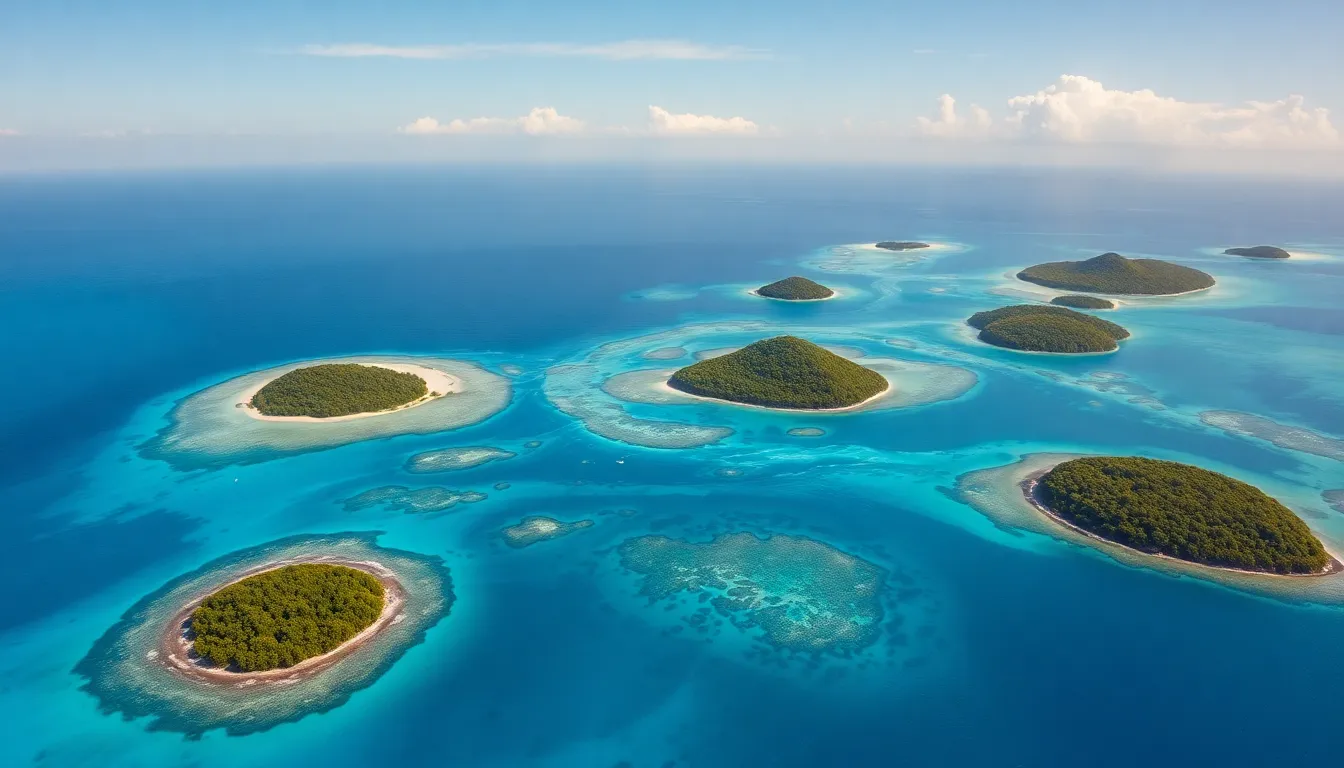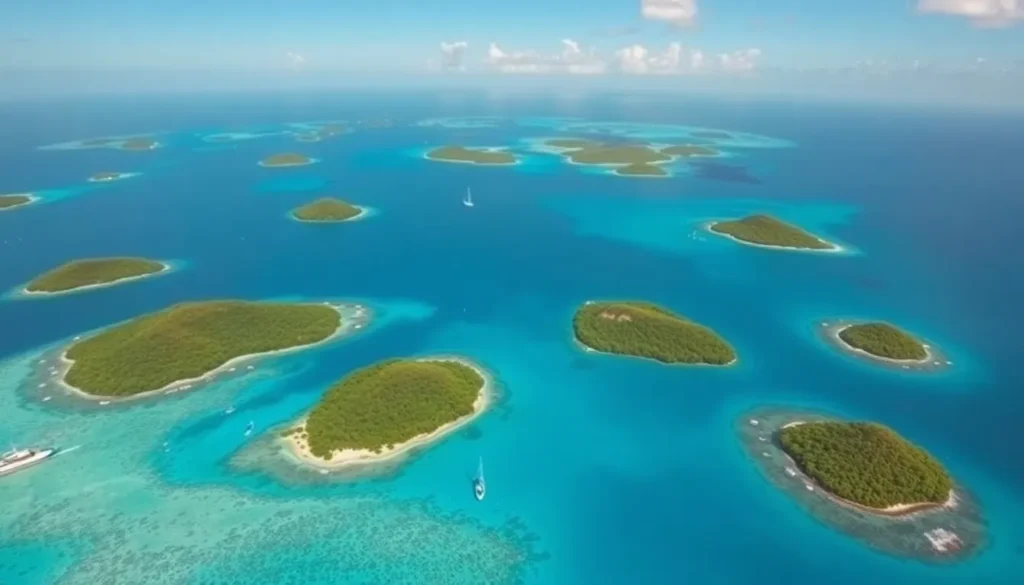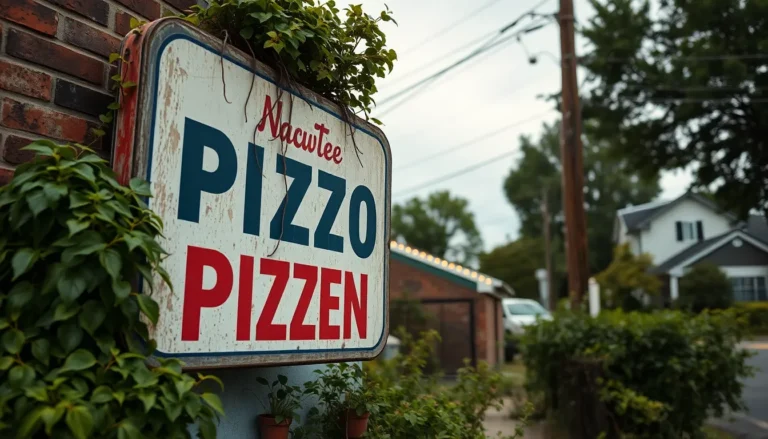Table of Contents
ToggleThe Caribbean Sea, a vibrant gem of the Western Hemisphere, captivates travelers and geographers alike. Nestled between Central America and the islands of the Greater and Lesser Antilles, this stunning body of water is more than just a tropical paradise. Its rich history, diverse ecosystems, and strategic importance make it a focal point on the world map.
When exploring the Caribbean Sea on a map, one can appreciate its unique shape and the multitude of islands that dot its surface. Each island boasts its own culture and natural beauty, contributing to the region’s allure. Understanding the Caribbean Sea’s location and significance not only enhances one’s geographical knowledge but also deepens appreciation for this extraordinary part of the world.
Overview of the Caribbean Sea
The Caribbean Sea is a critical body of water, known for its captivating geography and distinctive location. It captivates travelers and scholars alike through its diverse ecosystems and unique cultural landscape.
Geographic Location
The Caribbean Sea lies southeast of the Gulf of Mexico and is bordered by Central America to the west and south. It extends to the Greater and Lesser Antilles in the north and east, respectively. The sea covers an area of approximately 2.754 million square kilometers, making it one of the largest seas in the world. Notable geographical features include the Caribbean Islands, over 7,000 in total, and the surrounding oceanic basins, which contribute to its ecological diversity.
Key Countries and Islands
The Caribbean Sea encompasses numerous countries and islands, each possessing rich histories and cultures. Significant nations in this region include:
- Cuba: The largest island, known for its vibrant culture and diverse landscapes.
- Jamaica: Famous for its beaches and reggae music, it attracts millions of tourists annually.
- Dominican Republic: Shares the island of Hispaniola with Haiti and is known for its colonial history and resorts.
- Puerto Rico: A U.S. territory celebrated for its unique blend of Spanish and American influences.
In addition to these countries, the Caribbean Sea hosts smaller islands such as:
- Barbados
- Saint Lucia
- Trinidad and Tobago
- Grenada
Each island exhibits distinct natural beauty, cultural practices, and ecological systems. Consequently, the Caribbean Sea’s countries and islands serve as vital contributors to the global tourism industry, drawing millions of visitors for their natural allure and cultural richness.
Importance of the Caribbean Sea

The Caribbean Sea holds immense significance in various aspects, contributing to the economy and environment of the region.
Economic Significance
Economic activities thrive in the Caribbean Sea, making it a key area for trade and tourism. The region generates substantial revenue from tourism, attracting over 30 million visitors annually who seek its beaches and cultural experiences. Fishing remains a vital industry, providing livelihoods for local communities and contributing to food security. Shipping channels through the Caribbean connect major trade routes, enhancing international commerce. The presence of oil and natural gas reserves further underscores its economic potential, with several countries investing in exploration and development.
Environmental Impact
The Caribbean Sea plays a crucial role in maintaining ecological balance. Its coral reefs support diverse marine biodiversity, including over 500 species of fish and numerous invertebrates. These ecosystems, vital for tourism and fisheries, are under threat from climate change, pollution, and overfishing. Protecting these habitats is essential for preserving the region’s natural beauty and supporting local economies. Conservation efforts focus on reducing plastic waste and implementing sustainable fishing practices to safeguard marine life. The sea also influences weather patterns and climate conditions, affecting both the environment and agriculture across the Caribbean.
Historical Context
The Caribbean Sea’s historical background significantly shapes its current geography and culture. Key events in exploration and colonization influenced the demographic and cultural landscape of the region.
Exploration and Colonization
Exploration of the Caribbean Sea began in the late 15th century. Christopher Columbus’ voyages in 1492 marked the first European contact with indigenous populations. The Spanish claimed numerous islands, establishing colonies and exploiting resources. Subsequent waves of European powers, including the British, French, and Dutch, sought control over these territories. By the 17th century, the Caribbean became a focal point for trade, sugar production, and the transatlantic slave trade. Colonization led to profound transformations, as European settlers brought new agricultural practices and established plantations, displacing indigenous communities and altering local economies. The legacy of colonization persists today, as it set the foundations for the modern Caribbean society and economy.
Cultural Influence
Cultural influence in the Caribbean Sea region stems from its diverse history. Indigenous peoples, European colonizers, and African enslaved populations all contributed to the cultural tapestry. African heritage remains prominent, evident in music, dance, and culinary traditions. European influences are apparent in the languages spoken, with Spanish, English, French, and Dutch prevalent across different islands. Additionally, indigenous cultures contribute unique elements to local identities, reflecting a blend of traditions. Festivals and celebrations, like Carnival in Trinidad and Tobago, showcase this rich cultural diversity, attracting visitors and reinforcing a shared Caribbean identity. The amalgamation of these influences creates a vibrant cultural landscape that endures in contemporary society.
Navigating the Caribbean Sea on World Map
Navigating the Caribbean Sea on a world map reveals a plethora of significant landmarks and vital maritime routes. This region showcases a blend of natural beauty and critical transport arteries essential for trade and tourism.
Major Landmarks
Caribbean Sea landmarks include key islands, archipelagos, and cultural sites. Notable islands visible on maps include:
- Cuba: The largest island, known for its rich history and vibrant culture.
- Jamaica: Famous for its reggae music and stunning landscapes.
- Hispaniola: Home to Haiti and the Dominican Republic, showcasing diverse heritage.
- Puerto Rico: A U.S. territory known for its colonial architecture and beautiful beaches.
- Barbados: Identified for its unique culture and historical significance.
These landmarks contribute not only to the geography but also to the cultural tapestry of the Caribbean region, making them significant for travelers and historians alike.
Maritime Routes
Maritime routes within the Caribbean Sea facilitate global commerce and regional trade. Key maritime routes include:
- Panama Canal Route: Connects the Atlantic and Pacific Oceans, essential for international shipping.
- Turks and Caicos Passage: Important for vessels traveling between Florida and the Caribbean.
- Windward Passage: Connects the Atlantic with the Caribbean, crucial for trade between the U.S. and Central America.
These routes support substantial economic activities, enhancing shipping efficiency and fostering tourism, making them vital to the region’s economic stability.
The Caribbean Sea stands out not only for its stunning beauty but also for its vital role in global trade and tourism. Its diverse islands and rich cultures offer a unique blend of experiences that captivate millions each year. Understanding its geographical significance enhances appreciation for the region’s ecological and economic contributions.
As the Caribbean faces challenges like climate change and pollution, the importance of conservation efforts becomes increasingly clear. Protecting its vibrant ecosystems ensures that future generations can enjoy the natural wonders and cultural heritage that define this remarkable area. The Caribbean Sea remains a key player in shaping the history and identity of its surrounding nations, making it an essential part of our world map.




